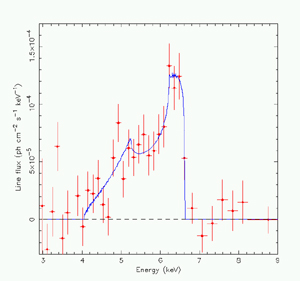The Anatomy of Black Holes - Page 7
 |
ASCA Satellite energy spectrum of the source MGC-6-30-15. The "double horn" feature is created by the superstrong gravity near the black hole.
|
| Credit: Tanaka, et al., Nature, 375,659,1995 | |
Let us now stretch our imaginations by taking a trip into a black hole. What happens to you as you journey into a black hole depends on how massive the black hole is, but maybe not in the way you might imagine! Let us consider the forces, called tidal forces, which your body will experience as you spiral closer to the event horizon of a black hole.
Suppose that you are in a spaceship safely orbiting a 10 solar mass black hole. You decide to get closer to the event horizon, which has a radius of about 30 km). At a radial distance of around 15,000 km you already know that something strange is going on. Inside your spaceship, with your head toward the stars and your feet toward the black hole, you begin to feel a slight pull downward on your feet and upward on your head. This is the onset of the amazing tidal forces surrounding a black hole. These are the same forces as the Earth exerts on you when you stand on its surface. However, the difference between the force exerted by the Earth on your head versus your feet because one is further away from the center than the other is miniscule…less than one part in a million. For the superstrong gravitational field of black hole, however, it is not so trivial. Even at a large distance from the event horizon such as 15,000 km, the difference between the gravitational pull on your head and your feet is about 1/8 of the Earth’s gravitational pull. Uncomfortable, but not painful, you continue to spiral in slowly to a distance of about 8,000 km. At this point, you experience a stretch of 4 times the Earth’s gravity. Things are not fun anymore, but continue on toward 3,000 km. There is now a 15g stretching force. You cannot stand it. You give up and move your spaceship back to a comfortable distance. Whew!




